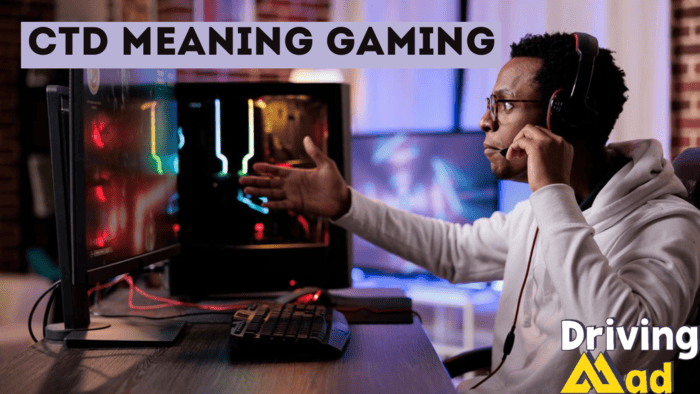Hey, gamers and tech troubleshooters! Let’s talk about a term that every PC player dreads: CTD.
No, it’s not an exciting new in-game feature—it’s the kind of problem that can abruptly end your session and leave you staring at your desktop in frustration.
Let’s explore what CTD means, what causes it, and how to prevent it from ruining your gameplay.

What Does CTD Mean in Gaming?
CTD stands for “Crash to Desktop.” It refers to a game suddenly closing without warning and returning the player to their computer’s desktop.
Unlike freezes or system shutdowns, a CTD doesn’t bring up error messages or blue screens—it just abruptly shuts the game down, often at the worst possible moment.
Where Did the Term CTD Come From?

The phrase “Crash to Desktop” has been used for years, becoming widely recognized in the late 1990s and early 2000s as PC gaming grew more advanced.
Back in the DOS era, crashes often resulted in a frozen screen or forced restarts, but as Windows-based games became the norm, a new kind of failure emerged—one where the game would simply exit without explanation. That’s when gamers started calling it a CTD.
Common Causes of CTDs
There are many reasons a game might suddenly close on its own. Some of the most frequent issues include:
- Hardware Problems – Overheating, bad RAM, or unstable overclocks can trigger crashes.
- Outdated or Corrupt Drivers – Graphics card drivers are a major cause of game instability.
- Software Conflicts – Background applications can interfere with the game’s performance.
- Mod Issues – Using mods that aren’t compatible with each other or the game’s latest version can lead to CTDs.
- Corrupt Game Files – If essential files are damaged or missing, the game may fail to run properly.
- Insufficient System Resources – Running a game on hardware that doesn’t meet its requirements can result in crashes.
- Game Bugs – Sometimes, the problem isn’t on your end—bugs in the game’s code can be responsible.
- Operating System Issues – Outdated or damaged OS files can cause instability.
How to Fix a Game That Keeps Crashing to Desktop?

While frustrating, CTDs can often be resolved with a few troubleshooting steps:
- Update Your Drivers – Make sure your GPU and other hardware drivers are up to date.
- Verify Game Files – Use your gaming platform’s built-in tool to check for and repair corrupted files.
- Install Game Updates – Developers frequently release patches to fix stability issues.
- Close Background Apps – Disable unnecessary programs that could interfere with the game.
- Monitor Your PC’s Temperature – Overheating can cause sudden crashes, so check your cooling system.
- Lower Graphics Settings – Reducing graphical demand can help with stability.
- Reinstall the Game – If nothing else works, a fresh installation might resolve the issue.
- Keep Your OS Updated – Ensure Windows (or your operating system) is fully patched.
- Check Event Viewer Logs – On Windows, the Event Viewer can provide clues about why the crash happened.
When Do Gamers Talk About CTDs?
You’ll see the term CTD pop up in various gaming conversations, such as:
- Bug Reports – “CTD occurs when entering a specific area of the map.”
- Tech Support Threads – “Frequent CTDs after the latest patch. Anyone else having this issue?”
- Modding Discussions – “This mod is great, but it’s causing CTDs when used with another one.”
- Game Reviews – “Fantastic gameplay, but the CTDs make it hard to enjoy.”
- Patch Notes – “Fixed an issue that caused CTDs when loading saved games.”
Other Related Terms
CTD is just one type of gaming crash. Here are some other terms that often come up in discussions about game stability:
- BSOD (Blue Screen of Death) – A critical Windows error that forces the system to restart.
- Crash Dump – A file created when a program crashes, used for debugging.
- Memory Leak – A software issue where a game gradually consumes more memory than it should, leading to instability.
- Benchmarking – Running performance tests to check a system’s capability.
- Rollback – Reverting to an earlier version of a game or driver to fix issues.
- Overclocking – Pushing hardware beyond its factory settings, which can cause instability if not managed correctly.
Final Thoughts
CTDs are frustrating, but with the right approach, they can often be fixed or minimized.
Keeping your system updated, monitoring hardware performance, and troubleshooting conflicts can go a long way in preventing crashes.
Hopefully, with these tips, your gaming sessions will stay uninterrupted, and your games will run smoothly from start to finish.

